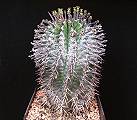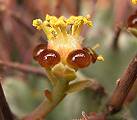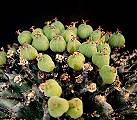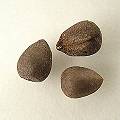|
Fotos |
1 Wuchsform 2
Weibliche Pflanze 3 Männliche Pflanze 4
Weitere Wuchsform 5 Ast 6 Männliches Cyathium,
braune Form 7 Männliches Cyathium, grüne Form 8 Weibliches Cyathium,
grüne Form 9
Früchte A
Frucht B Wuchsform C
Scheitel D Wuchsform E Junger
Kamm F
Alter Kamm G Ast H
Scheitel I
Äste |
|
Photos |
1 Growth form
2 Female plant 3
Male plant 4 Another growth form 5
Branch 6 Male cyathium, brown form 7
Male cyathium, green form 8 Female cyathium, green form 9 Fruits A Fruits B Growth form
C Apex D Growth form
E Young fan F Adult fan G Branch H Apex I Branches |
|
Erstbeschreibung |
Boissier 1860, Cent. Euphorb.
27 |
|
Initial
description |
|
|
Heimat |
RSA (Eastern Cape) |
|
Habitat |
RSA (Eastern Cape) |
|
Wuchsform |
|
|
Growth
form |
|
|
Cyathien |
|
|
Cyathia |
|
|
Kalender |
|
|
Calendar |
|
|
Samen |
|
|
Seed |
|
|
Kultivierung |
|
|
Cultivation |
|
|
Min. Temperatur |
10 °C |
|
Min. temperature |
50 °F |
|
Schädlinge &
Krankheiten |
(keine beobachtet) |
|
Pests and diseases |
(not any observed) |
|
Ähnliche
Arten |
|
|
Similar species |
|
|
Weitere Informationen |
Alle var. der E. horrida sind recht variabel in Größe und Farbe und deshalb nur schwer zu unterscheiden. E.
horrida var. horrida ist normalerweise weiß. Abhängig von
Jahreszeit und Kulturbedingungen können die Pflanzen jedoch recht
unterschiedlich aussehen. E. horrida
var. major ist dunkel grün-grau und bildet im Alter sehr
dicke Stämme. E. horrida var. striata
unterscheidet sich durch bläulich-grüne bis silbrige Stämme und durch im Alter
sehr wellige Rippen mit weißen Streifen. E.
horrida var. noorsveldensis ist
E. polygona sehr ähnlich. Sie hat dünnere und matt bläulich-grüne
Stämme. E.
horrida „var. minor“ ist keine echte Varietät, aber eine schöne
Form, die schon ab einer Große von etwa 3 cm blüht. Sehr nahe verwandt ist die
auch sehr variable E. polygona. Je nach Standort sind die Pflanzen
bis zu einem Meter groß, weiß, wellig gerippt und stark bedornt bis zu sehr
klein, hellgrün und fast dornenlos. Im Habitat kommen Übergangsformen
zwischen E. horrida und polygona vor. Grundsätzlich hat E. polygona grünere
und dünnere Stämme. Auch E. anoplia ist
sehr nahe verwandt. Sie ist von fast dornenlose Formen der E. horrida /
polygona kaum zu unterscheiden Eine Revision der
Euphorbien wird E. horridoa, polygona und anoplia möglicherweise zu
Unterarten oder Varietäten einer einzigen Art und die jetzigen Varietäten zu
Formen reduzieren. Foto 2
und 3: Form von Seweekspoort Foto A
und B: Form von De Rust Euphorbia horrida ist
natürlicher Wirt des Parasiten Viscum
minimum. |
|
Additional
information |
All
var. of E. horrida are quite variable in size and colour and therefore hard
to distinguish. E. horrida var. horrida is usually white. Depending on season and
cultivation conditions the plants look quite different, however. E. horrida var. major is dull green-gray and builds very thick stems with the age. E.
horrida var. striata
differs in having stems which are bluish grey to silver, and the with the age
very wavy angles which are marked with stripes. E. horrida var. noorsveldensis is very
similar to E. polygona. It has more narrow and dull bluish-grey stems. E. horrida „var. minor“ isn’t a true variety but a nice form that flowers
already when about 3 cm in height. Very
close related is the also very variable E. polygona. Depending on
the certain habitat the plants are up to 1 m high, white, wavy ripped and
heavy thorned to small, light green and almost thornless. There are
transitional forms beween E. horrida and polygona occuring in habitat.
Generally E. polygona is greener and has more narrow stems. Also
E.
anoplia is very close related. One can hardly tell it apart
from nearly thornless forms of E. horrida / polygona. A
revision of the Euphorbias will eventually reduce E. horrida, polygona und
anoplia to subspecies or varieties of one single species, and the present
varieties to forms. Photo 2 and 3: Form from Seweekspoort Photo A and B: Form from De Rust Euphorbia
horrida is natural host of the parasite
Viscum minimum. |
Fanden Sie diese Seite ohne einen linken Rahmen, laden Sie bitte www.euphorbia.de
If you found this page without a left frame
please load www.euphorbia.de
























